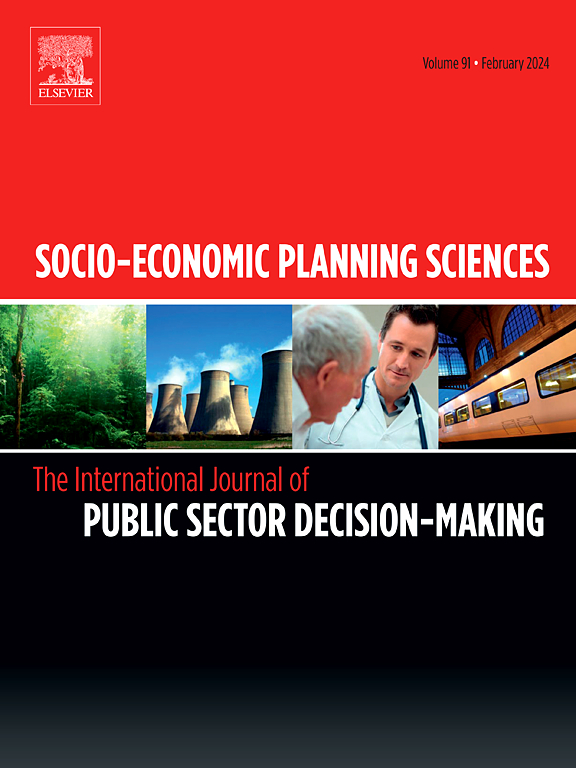Risk management of the vaccine supply chain: Interactions of risk factors and control strategies
IF 5.4
2区 经济学
Q1 ECONOMICS
引用次数: 0
Abstract
Existing research on vaccine supply chain (VSC) risk management often focuses on transportation or production stages or simply lists risk factors, lacking comprehensive identification and exploration of their interrelationships. This paper aims to address this gap by identifying and systematically analyzing risk factors in the single-dose COVID-19 VSC, emphasizing their structural hierarchy, interrelationships, and relative importance. The study summarizes VSC risk factors using the Supply Chain Operations Reference (SCOR) model. It innovatively combines Total Interpretive Structural Modeling (TISM) with Cross-Impact Matrix Multiplication Applied to Classification (MICMAC) and complex network theory. This yields the TISM hierarchical model, a driving power-dependence matrix, and comprehensive importance values for all risk factors. The TISM model reveals that risk awareness level, human resource level, and supplier selection capability are at the base level, functioning as fundamental factors with deep regulatory effects. The driving power-dependence matrix indicates that risk awareness level, human resource level, and supplier selection capability are independent factors characterized by high driving power and low dependence. The comprehensive importance calculations rank delivery integrity and product quality level at the top. Furthermore, sensitivity analysis is also performed to check the robustness of the proposed model. Understanding the relationships between risk factors, elucidating their logical explanations, and identifying key risk factors enable stakeholders to better manage risks and stabilize VSC operations.
疫苗供应链的风险管理:风险因素和控制策略的相互作用
现有的疫苗供应链风险管理研究往往侧重于运输或生产阶段,或简单列出风险因素,缺乏对其相互关系的全面识别和探索。本文旨在通过识别和系统分析单剂量COVID-19 VSC中的危险因素,强调其结构层次、相互关系和相对重要性,解决这一差距。本研究运用供应链运作参考模型(Supply Chain Operations Reference, SCOR)对供应链供应链的风险因素进行了总结。它创新性地将全解释结构建模(Total Interpretive Structural Modeling, TISM)、交叉冲击矩阵乘法应用于分类(Cross-Impact Matrix Multiplication Applied to Classification, MICMAC)和复杂网络理论相结合。这产生了TISM层次模型,驱动功率依赖矩阵,以及所有风险因素的综合重要性值。根据该模型,风险意识水平、人力资源水平和供应商选择能力处于基础水平,是具有深层调控作用的基础性因素。驱动功率依赖矩阵表明,风险意识水平、人力资源水平和供应商选择能力是驱动功率高、依赖程度低的独立因素。综合重要性计算将交付完整性和产品质量水平排在首位。此外,还进行了敏感性分析以检验所提出模型的鲁棒性。了解风险因素之间的关系,阐明其逻辑解释,并确定关键风险因素,使利益相关者能够更好地管理风险并稳定VSC运营。
本文章由计算机程序翻译,如有差异,请以英文原文为准。
求助全文
约1分钟内获得全文
求助全文
来源期刊

Socio-economic Planning Sciences
OPERATIONS RESEARCH & MANAGEMENT SCIENCE-
CiteScore
9.40
自引率
13.10%
发文量
294
审稿时长
58 days
期刊介绍:
Studies directed toward the more effective utilization of existing resources, e.g. mathematical programming models of health care delivery systems with relevance to more effective program design; systems analysis of fire outbreaks and its relevance to the location of fire stations; statistical analysis of the efficiency of a developing country economy or industry.
Studies relating to the interaction of various segments of society and technology, e.g. the effects of government health policies on the utilization and design of hospital facilities; the relationship between housing density and the demands on public transportation or other service facilities: patterns and implications of urban development and air or water pollution.
Studies devoted to the anticipations of and response to future needs for social, health and other human services, e.g. the relationship between industrial growth and the development of educational resources in affected areas; investigation of future demands for material and child health resources in a developing country; design of effective recycling in an urban setting.
 求助内容:
求助内容: 应助结果提醒方式:
应助结果提醒方式:


